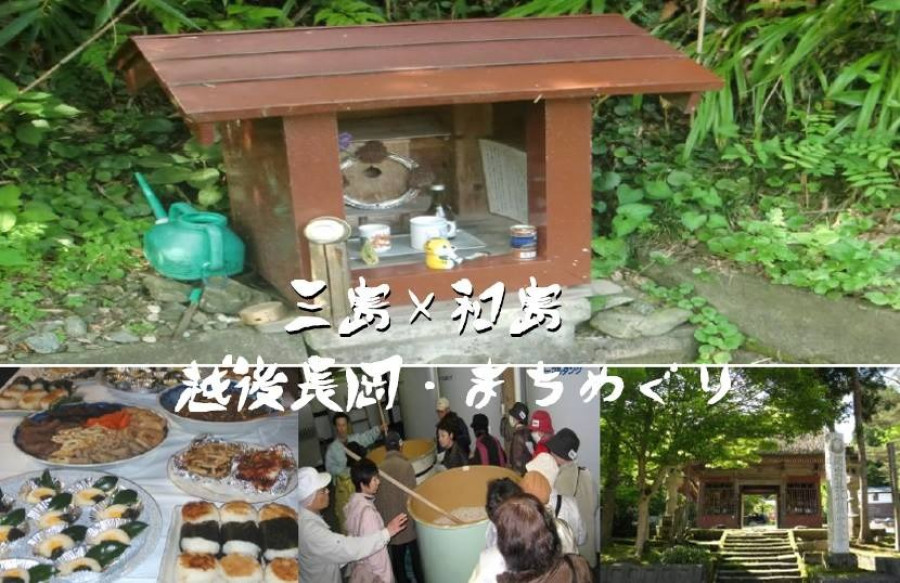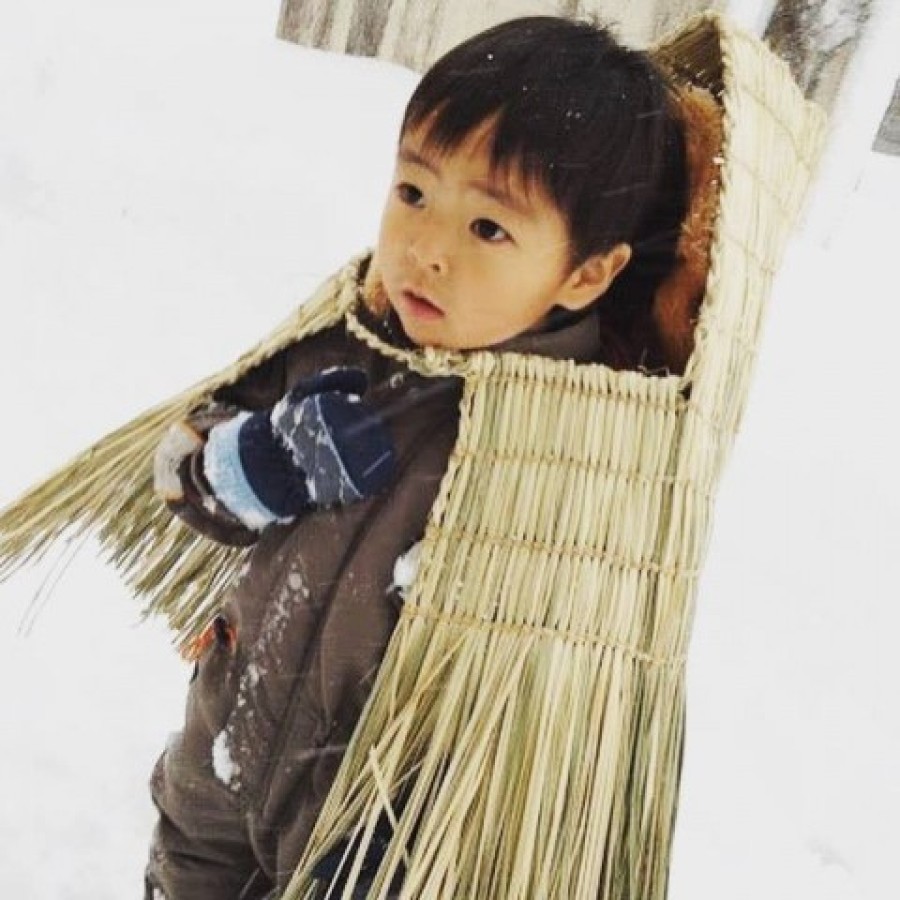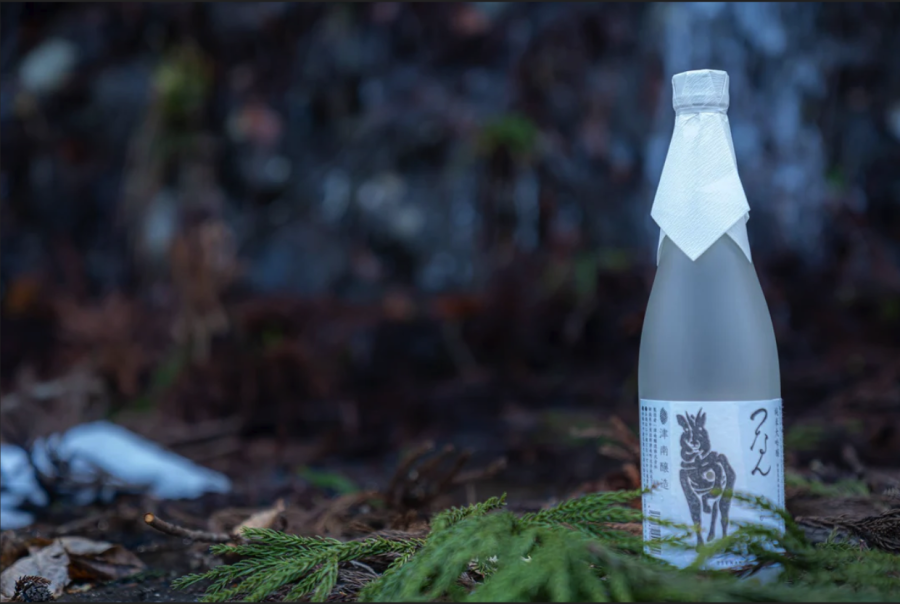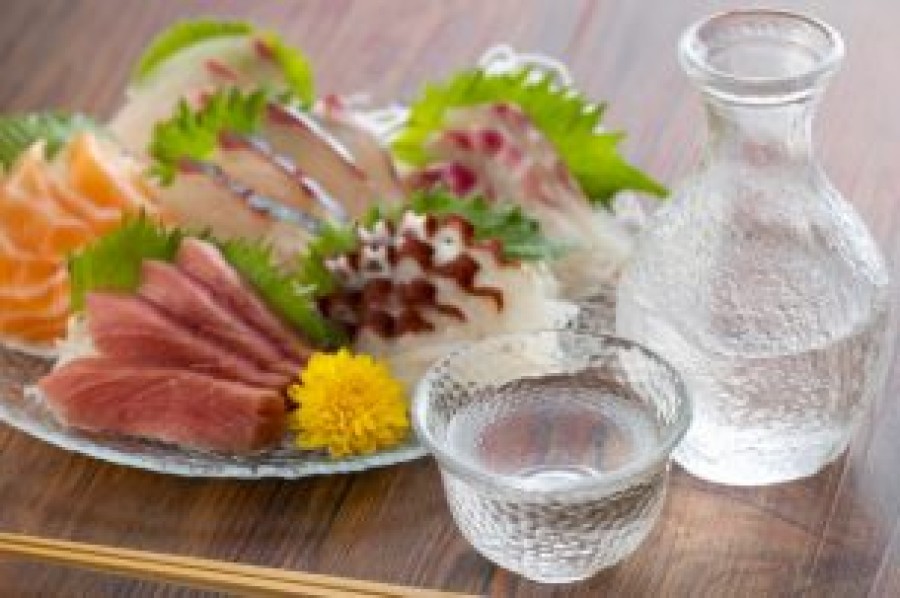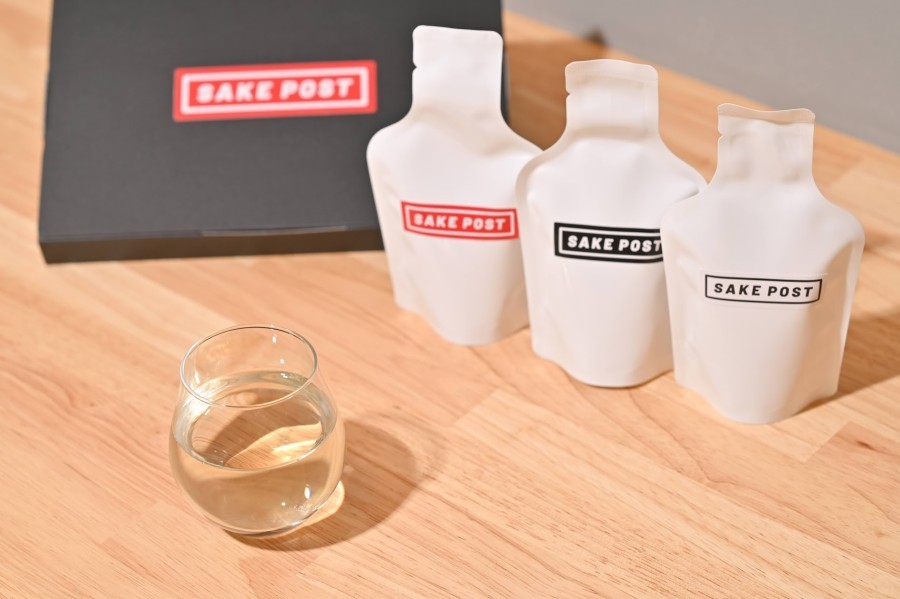There are many hidden attractions in the region that are only discovered when you walk around from the perspective of the local people. The Echigo Nagaoka Town Tour is a town tour to rediscover such treasures that abound in Nagaoka City. This time we report on a tour of Mishima and Wajima held on 29 October.
![Tour to Mishima and Wajima on a phantom bus route to get in touch with 'spring water culture and the Soga story'! Echigo Nagaoka Machi-meguri].](https://niigata-repo.com/wp-content/uploads/2014/11/IMGP5199-546x361.jpg)
The common keywords of the Mishima and Wajima regions are 'spring water culture and the Soga story'. The participants learnt about the brewing culture fostered by the spring water and the great local people while touring a phantom bus route. The schedule for the day was as follows.
- Meet: 9:30am at the Saiwai Plaza.
- [Morning] Mishima area (1) 'Nakagawa Sake Brewery' - (2) 'Kanmasuji Temple, Tomb of Soga Zenji Boy' - (3) 'Walking in the Gyakudani community'.
- Lunch: 4) Myohoji Temple (lunch).
- Afternoon] Wajima area (5) 'Ikeura Sake Brewery' - (6) 'Ido God' - (8) 'Sumiunen'
- Dismissal: 15:30 Arrival at Saiwai Plaza
![Tour to Mishima and Wajima on a phantom bus route to get in touch with 'spring water culture and the Soga story'! Echigo Nagaoka Machi-meguri].](https://niigata-repo.com/wp-content/uploads/2014/11/IMGP5192-546x361.jpg)
![Tour to Mishima and Wajima on a phantom bus route to get in touch with 'spring water culture and the Soga story'! Echigo Nagaoka Machi-meguri].](https://niigata-repo.com/wp-content/uploads/2014/11/IMGP5206-546x361.jpg)
First, all participants met at the Mishima branch office for staff introductions. This time there were 17 participants and a whopping 21 staff members (laughs) who enjoy the tour together with the local volunteers who participate as staff.
(i) Mishima area, 'Nakagawa Brewery'.
![Tour to Mishima and Wajima on a phantom bus route to get in touch with 'spring water culture and the Soga story'! Echigo Nagaoka Machi-meguri].](https://niigata-repo.com/wp-content/uploads/2014/11/IMGP5288-546x361.jpg)
The first place to visit is the Nakagawa Shuzo, famous for its Echino Shiragane. The company was founded in the middle of the Meiji era (1868-1912) by the fifth generation of Naemon from a money changer's shop.
![Tour to Mishima and Wajima on a phantom bus route to get in touch with 'spring water culture and the Soga story'! Echigo Nagaoka Machi-meguri].](https://niigata-repo.com/wp-content/uploads/2014/11/IMGP5194-546x361.jpg)
A map of springs was handed out as part of the materials distributed this time, and this area of Wakino-cho in the Mishima region is an area with a great many springs. This is why there were six sake breweries in the Wakino-machi area at the height of the Edo period! Now they say that the number has decreased to three, but it is surprising that there are so many sake breweries in this small town with a population of around 3,000 people. It is also because the local people are extreme drinkers! It's not because the local people are extreme drinkers, but because the land is blessed with good quality water.
![Tour to Mishima and Wajima on a phantom bus route to get in touch with 'spring water culture and the Soga story'! Echigo Nagaoka Machi-meguri].](https://niigata-repo.com/wp-content/uploads/2014/11/IMGP5229-546x361.jpg)
![Tour to Mishima and Wajima on a phantom bus route to get in touch with 'spring water culture and the Soga story'! Echigo Nagaoka Machi-meguri].](https://niigata-repo.com/wp-content/uploads/2014/11/IMGP5245-546x361.jpg)
The brewery is shown to us with an explanation of its interior. The Meiji warehouse has been in use since the very beginning. You can feel the history.
![Tour to Mishima and Wajima on a phantom bus route to get in touch with 'spring water culture and the Soga story'! Echigo Nagaoka Machi-meguri].](https://niigata-repo.com/wp-content/uploads/2014/11/IMGP5258-546x361.jpg)
And this brewing water is characteristic of the Nakagawa Brewery. Look at the picture. Doesn't it look light blue? Yes, the brewing water used by the Nakagawa Brewery is light blue! It is the colour of the water as it is drawn up, but it contains minerals and other substances that naturally give it this colour. It may be hard to tell from the photo, but it really is a beautiful water colour!
![Tour to Mishima and Wajima on a phantom bus route to get in touch with 'spring water culture and the Soga story'! Echigo Nagaoka Machi-meguri].](https://niigata-repo.com/wp-content/uploads/2014/11/IMGP5303-546x361.jpg)
And there was also time for tasting, a familiar (?) feature of sake brewery tours! There was also time for tasting, which is a familiar (?) feature of sake brewery tours! I couldn't drink it because I was coming by car, but everyone was enjoying comparing the different drinks! I think sake tastes even better when you hear how particular the brewery is about it!
![Tour to Mishima and Wajima on a phantom bus route to get in touch with 'spring water culture and the Soga story'! Echigo Nagaoka Machi-meguri].](https://niigata-repo.com/wp-content/uploads/2014/11/IMGP5311-546x361.jpg)
Wakino-cho in the Mishima region is rich in spring water. Near the Nakagawa Sake Brewery is the Maruya Kimigayo. It is said that this spring is famous for its spring water called 'Jomon Snow Icicle Water', and many members of the public came to fill their plastic bottles with the water.
(ii) Mishima area, 'Tomb of Soga Zenji-bo, Kanmasu-ji Temple'.
![Tour to Mishima and Wajima on a phantom bus route to get in touch with 'spring water culture and the Soga story'! Echigo Nagaoka Machi-meguri].](https://niigata-repo.com/wp-content/uploads/2014/11/IMGP5342-546x361.jpg)
The bus then took us to our next destination, Kanmikji Temple. The temple is located in a very quiet village and gives a sense of history. The temple was founded by Gyoki in 719 during the Heian period (794-1185) and is a very old temple.
![Tour to Mishima and Wajima on a phantom bus route to get in touch with 'spring water culture and the Soga story'! Echigo Nagaoka Machi-meguri].](https://niigata-repo.com/wp-content/uploads/2014/11/IMGP5333-546x361.jpg)
The temple has long been a place of worship, and it is said that even Uesugi Kenshin came to pray at the temple. The temple is well known among temple lovers for its Niomon Gate, where a statue of Kongorikishi is enshrined, and for its many standing statues in its collection, including the main statue of Yakushi Nyorai, the Four Heavenly Kings and the Twelve Divine Generals, which are designated cultural assets.
![Tour to Mishima and Wajima on a phantom bus route to get in touch with 'spring water culture and the Soga story'! Echigo Nagaoka Machi-meguri].](https://niigata-repo.com/wp-content/uploads/2014/11/IMGP5336-546x361.jpg)
However, this time we did not pay attention to the designated cultural asset... (laughs) Here, we heard the story of 'Soga Zenshibo'. Zenshibo is the third son of the Soga brothers who appears in a military chronicle called Soga Monogatari, which is based on a revenge attack on the Soga brothers that took place in the early Kamakura period (1185-1333). It is said to be a famous Kabuki play, but I didn't understand it at all. ...... But I thought it was maniacal and nice.
![Tour to Mishima and Wajima on a phantom bus route to get in touch with 'spring water culture and the Soga story'! Echigo Nagaoka Machi-meguri].](https://niigata-repo.com/wp-content/uploads/2014/11/IMGP5352-546x361.jpg)
![Tour to Mishima and Wajima on a phantom bus route to get in touch with 'spring water culture and the Soga story'! Echigo Nagaoka Machi-meguri].](https://niigata-repo.com/wp-content/uploads/2014/11/IMGP5355-546x361.jpg)
The grave of Soga Zenji-bo was quietly located in a corner of the cemetery in the forest behind the main hall. It is good to know that ancient stories are still alive in the community. I hope that the storytellers will continue to tell the tale without interruption.
(iii) Mishima region, 'Walks in the Reverse Valley Settlements'.
![Tour to Mishima and Wajima on a phantom bus route to get in touch with 'spring water culture and the Soga story'! Echigo Nagaoka Machi-meguri].](https://niigata-repo.com/wp-content/uploads/2014/11/IMGP5378-546x361.jpg)
![Tour to Mishima and Wajima on a phantom bus route to get in touch with 'spring water culture and the Soga story'! Echigo Nagaoka Machi-meguri].](https://niigata-repo.com/wp-content/uploads/2014/11/IMGP5321-546x361.jpg)
We then heard stories about the area in the vicinity of the Kanmasuji Temple. A quiet village with nothing but the sound of the wind and birdsong. The tranquil atmosphere made me feel as if I had somehow slipped back in time to a bygone era. There were no sounds of people, cars, music or anything else, just nature.
![Tour to Mishima and Wajima on a phantom bus route to get in touch with 'spring water culture and the Soga story'! Echigo Nagaoka Machi-meguri].](https://niigata-repo.com/wp-content/uploads/2014/11/IMGP5317-546x361.jpg)
It then travels to the Wajima region via a 'phantom bus route'.
![Tour to Mishima and Wajima on a phantom bus route to get in touch with 'spring water culture and the Soga story'! Echigo Nagaoka Machi-meguri].](https://niigata-repo.com/wp-content/uploads/2014/11/IMGP5196-546x361.jpg)
The 'phantom bus route' between Mishima and Wajima is an important road that is said to have been used by Naoe Kanetsugu, lord of Yohita Castle, who was once featured in a historical drama, to go to Kasuga-yama Castle, the residence of Uesugi Kenshin and Kagayatsu. It is said that Okuma Tsutsumemon worked on a bus route linking Yoban with this road, called 'Sakasadani', which connects Mishima and Wajima, but due to natural disasters, the route did not go through Sakasadani and the idea disappeared into a mirage.
However, in the reverse valley, where people have been coming and going since ancient times, there are various anecdotes, including the legend of the dreaded 'Mamushi Pond' and the legend of Otekeke, where someone calls out 'Otekeke - Otekeke' to the fish carried by the peddlers.
(iv) Wajima area 'Myohoji' (lunch).
We came to the lunch venue, Myoho-ji Temple, by bus on such a fantastic bus route.
![Tour to Mishima and Wajima on a phantom bus route to get in touch with 'spring water culture and the Soga story'! Echigo Nagaoka Machi-meguri].](https://niigata-repo.com/wp-content/uploads/2014/11/IMGP5395-546x361.jpg)
Myoho-ji Temple is a Nichiren Shu temple with a 700-year history. Myoho-ji here in Wajima was the centre of Hokuetsu missionary work.
![Tour to Mishima and Wajima on a phantom bus route to get in touch with 'spring water culture and the Soga story'! Echigo Nagaoka Machi-meguri].](https://niigata-repo.com/wp-content/uploads/2014/11/IMGP5396-546x361.jpg)
![Tour to Mishima and Wajima on a phantom bus route to get in touch with 'spring water culture and the Soga story'! Echigo Nagaoka Machi-meguri].](https://niigata-repo.com/wp-content/uploads/2014/11/IMGP5416-546x361.jpg)
![Tour to Mishima and Wajima on a phantom bus route to get in touch with 'spring water culture and the Soga story'! Echigo Nagaoka Machi-meguri].](https://niigata-repo.com/wp-content/uploads/2014/11/IMGP5420-546x361.jpg)
A volunteer guide leads the way to the main hall. The red gate on the way is a cultural asset and the Niou statue looks amazing, but this time we couldn't get close because a hornet's nest had formed under the roof! Shame!
![Tour to Mishima and Wajima on a phantom bus route to get in touch with 'spring water culture and the Soga story'! Echigo Nagaoka Machi-meguri].](https://niigata-repo.com/wp-content/uploads/2014/11/IMGP5427-546x361.jpg)
![Tour to Mishima and Wajima on a phantom bus route to get in touch with 'spring water culture and the Soga story'! Echigo Nagaoka Machi-meguri].](https://niigata-repo.com/wp-content/uploads/2014/11/IMGP5442-546x361.jpg)
The inside of the main hall is glittering! A splendid temple is still maintained with the support of local people.
![Tour to Mishima and Wajima on a phantom bus route to get in touch with 'spring water culture and the Soga story'! Echigo Nagaoka Machi-meguri].](https://niigata-repo.com/wp-content/uploads/2014/11/IMGP5452-546x361.jpg)
This is where we will have our long-awaited lunch! This time we will have vegetarian food prepared by local mothers.
![Tour to Mishima and Wajima on a phantom bus route to get in touch with 'spring water culture and the Soga story'! Echigo Nagaoka Machi-meguri].](https://niigata-repo.com/wp-content/uploads/2014/11/IMGP5455-546x361.jpg)
![Tour to Mishima and Wajima on a phantom bus route to get in touch with 'spring water culture and the Soga story'! Echigo Nagaoka Machi-meguri].](https://niigata-repo.com/wp-content/uploads/2014/11/IMGP5457-546x361.jpg)
![Tour to Mishima and Wajima on a phantom bus route to get in touch with 'spring water culture and the Soga story'! Echigo Nagaoka Machi-meguri].](https://niigata-repo.com/wp-content/uploads/2014/11/IMGP5459-546x361.jpg)
Even though it's vegetarian food, it's gorgeous, just no meat or fish! It was very tasty and full of mountain produce.
5) Wajima region 'Ikeura Brewery'.
In the afternoon, when we were full, we visited the sake brewery again. This time to the Ikeura Sake Brewery in Wajima.
![Tour to Mishima and Wajima on a phantom bus route to get in touch with 'spring water culture and the Soga story'! Echigo Nagaoka Machi-meguri].](https://niigata-repo.com/wp-content/uploads/2014/11/IMGP5528-546x361.jpg)
Like Mishima, Wajima is also a place with abundant spring water: "There are two sake breweries in a place with only 4,000 inhabitants. It is said that this is because people like sake", and it seems that where the water is good, sake brewing also flourishes.
![Tour to Mishima and Wajima on a phantom bus route to get in touch with 'spring water culture and the Soga story'! Echigo Nagaoka Machi-meguri].](https://niigata-repo.com/wp-content/uploads/2014/11/IMGP5491-546x361.jpg)
Take a tour of the brewery here as well. Ikeura Shuzo's representative brand is Waraku Goson. It is also marketed under the catchphrase 'sake from the village of Ryokan'. Incidentally, the use of natto (fermented soybeans) is not allowed in sake brewing! That's why the brewers don't eat natto!
![Tour to Mishima and Wajima on a phantom bus route to get in touch with 'spring water culture and the Soga story'! Echigo Nagaoka Machi-meguri].](https://niigata-repo.com/wp-content/uploads/2014/11/IMGP5514-546x361.jpg)
Of course, tasting here too! Everyone was talking about how tasty and delicious it was, and I was envious. And the bus was so full of the smell of alcohol that it was like returning from a banquet (laughs).
⑥ Wajima area 'well god'.
![Tour to Mishima and Wajima on a phantom bus route to get in touch with 'spring water culture and the Soga story'! Echigo Nagaoka Machi-meguri].](https://niigata-repo.com/wp-content/uploads/2014/11/IMGP5533-546x361.jpg)
Then to the sacred spring of the 'well god', which is said to cure eye diseases. Everyone tried the soft water. It is said that even in the same area, the taste of the water differs from spring to spring and each spring has its own story.
(7) Wajima Island area "Sumiyuen Garden
The last place we came to was Sumiyunen.
![Tour to Mishima and Wajima on a phantom bus route to get in touch with 'spring water culture and the Soga story'! Echigo Nagaoka Machi-meguri].](https://niigata-repo.com/wp-content/uploads/2014/11/IMGP5556-546x361.jpg)
This garden is said to have been created by Kusumi Rokurozaemon Masanobu in 1717 (Kyoho 2) during the Edo period and is one of the best gardens in Hokuetsu, visited by many writers and artists. It was also the residence of the Kusumi father and son, founders of the former Echigo Railway (now the JR Echigo Line), and was donated to Nagaoka City in 1972.
![Tour to Mishima and Wajima on a phantom bus route to get in touch with 'spring water culture and the Soga story'! Echigo Nagaoka Machi-meguri].](https://niigata-repo.com/wp-content/uploads/2014/11/IMGP5561-546x361.jpg)
The arrangement of fountain stones, garden stones and trees is said to be excellent, with a view of Mt Yahiko between the trees. The garden is said to be characterised by its many flat stones.
![Tour to Mishima and Wajima on a phantom bus route to get in touch with 'spring water culture and the Soga story'! Echigo Nagaoka Machi-meguri].](https://niigata-repo.com/wp-content/uploads/2014/11/IMGP5564-546x361.jpg)
There was a relaxed atmosphere that allowed people to escape from the hectic pace of modern life.
the end
Now the story of Mishima and Wajima, connected by a spring and a phantom bus route. We have seen a little glimpse of the history through the reverse valleys of the two historic regions. I have the impression that both regions are old areas where time somehow flows in a relaxed manner. As one of the tour participants said, "It's like the world of an old tale", and we were able to experience an atmosphere as if we had somehow slipped back in time. Among the Echigo Nagaoka town tours, I think this was the trip where I personally met the fewest people other than the tour participants. Perhaps because of this, I was able to enjoy a unique view of the world.
The Echigo Nagaoka Machi Meguri is organised and managed by the Echigo Nagaoka Machi Meguri Executive Committee. If you are interested in participating or have any questions, please check the information of the Echigo Nagaoka Machi Meguri Executive Committee!
- Official facebook page: https://www.facebook.com/pages/%E8%B6%8A%E5%BE%8C%E9%95%B7%E5%B2%A1%E3%81%BE%E3%81%A1%E3%82%81%E3%81%90%E3%82%8A2014 /694356533975334
- Kolite organisation page: http://nkyod.org/group-list/machimeguri
advertisement


